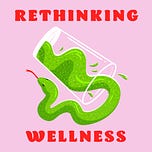
It’s Q&A time! You can ask your own question here for a chance to have it answered in an upcoming edition.
Just a reminder that these answers are for educational and informational purposes only, and aren’t a substitute for medical or mental-health advice. Although I am a registered dietitian, I’m not your dietitian (unless you happen to be one of my 1:1 clients—hi!—but even then, this email isn’t a session).
Today’s newsletter is a long one, so my answer to the first part of the first question is available to all subscribers (about hair analysis), and there are a few bonus ones just for paid subscribers (about DUTCH testing, what you’re really looking for with these kinds of tests, and how concerned you should be about recent reports of heavy metals in chocolate).
Hi Christy,
I just discovered your podcast before I was about to spend lots of money on testing, so thank you for all your insights. I’ve been following intuitive eating for years, but I am still healing and learning to accept my body.
I was wondering what your thoughts were on HTMA and DUTCH testing. Is this “new science”? They are so tempting to get for me because it would be so nice to see exactly where I’m lacking so I can just eat the foods that will heal my body and make it run “normally.” But I know there is no magic pill, as you say! Thank you.
—April
I’m so glad the podcast has been helpful to you, and thanks for the great question! My short answer is: I’d recommend continuing to save your money, because these tests aren’t based on solid evidence. They’re unlikely to tell you anything helpful, and they can provide misleading results that cause harm by convincing you to try unnecessary treatments or forgo evidence-based medicine.
I know that can be hard to hear when you want help and healing, especially if you haven’t been getting adequate support in the conventional healthcare system. We’ll come back to this question of what you’re hoping to gain from this kind of testing shortly. But first, let’s talk about each of these tests.
Hair Tissue Mineral Analysis (HTMA)
HTMA supposedly tests the mineral levels in your hair to find deficiencies and “imbalances,” which you can then ostensibly correct through food and supplements (often sold by the provider who ordered the hair analysis).
The problem is that hair can’t actually tell you those things. Like many problematic wellness practices, HTMA is based on a grain of truth: hair testing can help determine whether someone was exposed to illegal drugs, substances banned in sports, or actual poisons (although it has some limitations). But nutrients are a different story, and hair mineral analysis isn’t a precise enough method to use for general health and nutrition screening.
Researchers have known this for decades, going back at least to the 1980s—HTMA definitely is not “new science.” In 1985, a critical review of the evidence published by the Canadian Medical Association found that commercial hair analysis was “imprecise, unnecessary, and probably wasteful.” Minerals in hair don’t reliably indicate minerals in other body tissues—you could have low levels in your hair without having a deficiency, or you could have seemingly “normal” levels in your hair and actually be deficient.
What’s more, the review found, there was no scientific oversight or government regulatory control of information provided by commercial hair-analysis labs. “Therefore, the information may be inaccurate, misleading and even detrimental to the patient’s health,” the report concluded.
That same year, the Journal of the American Medical Association (JAMA) published a small study by medical doctor Stephen Barrett, who sent hair samples from two healthy teenagers to 13 different commercial hair-analysis companies. Barrett found that identical samples produced wildly different results when sent to different labs—and also when they were sent to the same lab under different names. In addition, the labs disagreed about what constituted “normal” values for many of the minerals.
A 2001 study set out to see if anything had changed in the 16 years since Barrett’s paper, and especially since the 1988 passage of the Clinical Laboratory Improvement Act (CLIA), which regulates clinical testing. But in 2001 the situation was still very much the same. “Hair mineral analysis from these laboratories was unreliable, and we recommend that health care practitioners refrain from using such analyses to assess individual nutritional status or suspected environmental exposures,” the researchers wrote. “Problems with the regulation and certification of these laboratories also should be addressed.”
More than a decade further on, these issues remained. A 2013 study of three different hair-analysis labs found that each lab reported different mineral deficiencies, which resulted in conflicting recommendations for supplements and treatments. One lab even reported different deficiencies for two samples of the same hair.
The main reason for these wide variations is that labs basically just make up their own definitions of “normal” because there are no established reference ranges for minerals in human hair. The ranges considered “normal” for blood tests can also vary a bit from lab to lab, but those variations are tiny compared to the large discrepancies in ranges for hair analysis.
Those inconsistencies exist in part because there’s no standard procedure for taking samples, preparing hair for analysis, or extracting minerals, as a 2013 systematic review noted. Until those things are standardized and scientifically validated, it’s impossible to come up with reliable reference ranges for hair analysis. Each testing company has its own protocols, which may or may not lead to internally consistent results at a given lab, but there’s still no evidence-based definition of “normal.”
Regulation of Lab Tests
Some proponents of hair analysis argue that only “bad” HTMA labs are problematic, and that if you go to a few specific labs that are CLIA-certified you’ll get valid results. But CLIA only requires labs to meet standards for things like staff qualifications, timeliness of results, and test accuracy/reliability within that particular lab environment (aka internal consistency). CLIA doesn’t require lab tests to be clinically valid or useful. So alt-med labs might be CLIA certified, but that doesn’t mean their tests are any good.
The Food and Drug Administration (FDA) historically took an “enforcement discretion” approach to labs offering these kinds of clinically useless tests, meaning that it basically looked the other way. But recently, the agency proposed starting to regulate lab-developed tests, citing their risks to patients. “The FDA is concerned patients could initiate unnecessary treatment, or delay or forego proper treatment altogether, based on inaccurate test results, which could result in harm, including worsening illness or death,” it stated in a news release.
The agency is seeking public comment on this proposed rule now, but only for another 5 days (I wish I’d gotten on this sooner!). If you want to support better regulation of lab tests, learn more and submit your comment here before December 4. For reference, here’s the comment I submitted:
I am writing in support of the FDA’s proposed rule to provide greater oversight of laboratory-developed tests (LDTs) and to phase out its general enforcement discretion approach to LDTs.
I am a registered dietitian and science journalist, and I hear from many people who are considering non-evidence-based tests such as those purporting to diagnose food intolerances with IgG antibodies, hair tissue mineral analysis for general health and nutrition, the GI-MAP test for gastrointestinal pathogens, and many others. In my review of the evidence (see selected references below), it has become clear to me that these tests can be extremely misleading and risky to patients, who may go on to use unnecessary and harmful treatments and turn away from evidence-based treatments.
Some of the companies producing these tests are simply businesses trying to compete in a crowded marketplace, but many are also savvy marketers that leverage consumer confusion and gaps in the conventional healthcare system. Patients can’t be expected to delve deeply into scientific literature in order to determine whether to take a particular lab test; they need to be able to trust that the tests recommended to them are clinically valid and useful, and that they won’t misinform or cause harm. This is where government oversight plays an essential role in consumer protection.
I urge the FDA to adopt this proposed rule and increase its oversight of LDTs.
Thank you for your time and consideration.
Sincerely,
Christy Harrison, MPH, RD
References:
Gingras, B. A., & Maggiore, J. A. (2020). Performance of a new molecular assay for the detection of gastrointestinal pathogens. Access Microbiology, 2(10), acmi000160. https://doi.org/10.1099/acmi.0.000160
Jones, S. L., Campbell, B., & Hart, T. (2019). Laboratory tests commonly used in complementary and alternative medicine: a review of the evidence. Annals of Clinical Biochemistry, 56(3), 310–325. https://doi.org/10.1177/0004563218824622
Kelso J. M. (2018). Unproven Diagnostic Tests for Adverse Reactions to Foods. The Journal of Allergy and Clinical Immunology. In Practice, 6(2), 362–365. https://doi.org/10.1016/j.jaip.2017.08.021
Thanks so much for the great question, April, and thanks to all the free subscribers for reading! Paid subscribers can stick around for the bonus answers (about DUTCH testing, what you’re really looking for with these kinds of tests, and how concerned you should be about reports of heavy metals in chocolate), and everyone can ask their own questions for a chance to have them answered in an upcoming newsletter.












